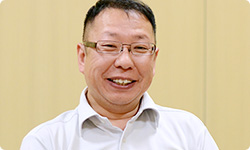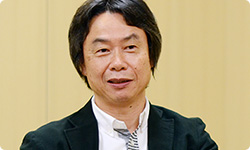2. Like Super Mario on the NES
So you began making Super Mario 3D Land in the mindset of an archaeologist, but how was it once you actually got started?
What made a deep impression on me was how the staff said it was like making the Super Mario Bros. game for the Nintendo Entertainment System.
In what way?
Well, I think it had many meanings.
An easy example is how you can stomp on enemies, which we did in a more 2D way - the stomping action this time is done in a more symbolic way than in Super Mario Galaxy or Super Mario Sunshine, which we had created to be more realistic.
In other words, you extracted the fun elements of Super Mario on the NES and imbued this game with them.
Exactly. And when it came to making corrections, we looked back at the processes we went through in the days of the NES.
You might say that you wanted the newest game to strongly reflect the point of origin of the series.
Yes, that’s right.
Tezuka-san, you were in charge of 2D Super Mario games. The 3D Super Mario games have always been Miyamoto-san’s sphere, while you were in a position slightly removed from them. What made you become actively involved this time?
I had never said much with regard to the 3D Super Mario games so far, but I sensed there were a lot of 2D Super Mario elements in this game, so I had things to say. I was like, “Let me chime in!” (laughs)

I heard last time in “Iwata Asks” that Iwata Asks: SUPER MARIO 3D LAND.
Yes. I thought it best to be clear up front.
How did that feel, Koizumi-san?
Well...I thought, “At last, we motivated him!” (laughs) This time, we were putting aside the game dynamic we had carried on since Super Mario 646 of searching and were trying to reconstruct the game with the original Super Mario dynamics. I think perhaps that is why Tezuka-san couldn’t help but feel as if it flowed like a 2D Super Mario game. 6Super Mario 64: The first 3D action game in the Super Mario series. Released for the Nintendo 64 system in Japan in June 1996.
Instead of having the player wander around the course looking for a Star like in the Super Mario Galaxy series, you have the player advance toward a Goal Pole, which reflects the origins of Super Mario. When I heard that from Tezuka-san, I thought, “What?!”
On the other hand, when I heard it, I thought, “Oh, yes!” and was ready to go all out! (laughs)
Joy and satisfaction were the core of the various points of Tezuka-san’s advice. For example, going back to collect scattered Coins was “ungenerous” now that running around 3D space was normal.
If I may add something regarding Coins, I have had various attitudes toward them myself. When we were making Super Mario Galaxy, at first we had it so the Coins would fly to the player-character of their own accord. But that felt impersonal, so we changed it so players have to go and get the Coins. That’s how I rationalised it to myself.
After all, the Coins only appear because you want to get them.
That’s right. But in this game, you head for a goal, so if they were scattered back in the opposite direction, gathering them would be a nuisance. What was correct in the past wasn’t necessarily right this time. And it was changed by me admitting my responsibilities in the matter.

This time there’s a timer, so the nature of the game is different. Collecting Coins would have interfered with the pace and tempo of the game.
A lot changed with regard to the timer as well.
Yes. Tezuka-san said it was too short, so I extended it. I think that was another reason that it didn’t feel generous.
In particular, Tezuka-san doesn’t trust how you’re supposed to go sideways in this game, as such he explores the foreground and background thoroughly, and does extra actions while he plays, meaning he.was taking longer to clear the levels. (laughs) Well, we do want people like that to play, too, so thinking about it the original time was too short.
As someone who had been away from 3D Super Mario for a while, what attracted you about this game, Tezuka-san?
Tanooki Mario, I think. I was the one who made Tanooki Mario for Super Mario Bros. 3, but I think this game displays Tanooki Mario’s features much better than in 2D. When you flip enemies, the tail spins right around, but in Super Mario Bros. 3, all you could do was smack left and right. This time you can wipe them out in a full 360-degree circle!
Tanooki Mario is perfect for a 3D world.
Yes. I thought, “Good job using something we made so long ago!”
Our professor of archaeology rediscovered Tanooki Mario!
Thank you! (laughs) Tezuka-san actually isn’t that good at playing 3D Mario games, but this time he played through to the end, which pleased me incredibly.
And that made you think 3D Super Mario is fun, right?
Oh, yes. (laughs)
Hayashida-san, having someone who wasn’t accustomed to Super Mario in 3D start by playing the 2D-like area and then suddenly find themselves enjoying 3D was exactly what you wanted!
Yes. I saw my first example of success with Tezuka-san! (laughs)
Before the game even went on sale!
A couple of guys in their 50s and nearing their 60s are already having a blast with it, so there’s no need to worry!
(laughs)